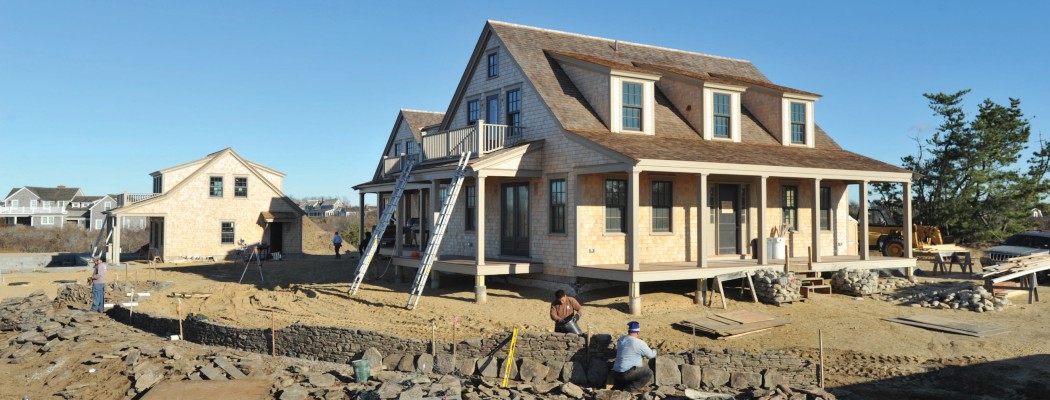Despite soaring lumber prices, Nantucket’s construction industry continues to surge.
 A little more than a year after the pandemic brought Nantucket’s construction industry to a screeching halt, building activity on the island has come roaring back despite a nationwide lumber shortage that has sent prices skyrocketing. In early June, the island quite literally ran out of white cedar shingles. There were simply none to be had. Local builders and lumberyards are navigating the current climate of seemingly unquenchable demand and runaway material costs by passing expenses on to buyers. Their clients and homeowners are absorbing the sticker shock with little hesitation.
A little more than a year after the pandemic brought Nantucket’s construction industry to a screeching halt, building activity on the island has come roaring back despite a nationwide lumber shortage that has sent prices skyrocketing. In early June, the island quite literally ran out of white cedar shingles. There were simply none to be had. Local builders and lumberyards are navigating the current climate of seemingly unquenchable demand and runaway material costs by passing expenses on to buyers. Their clients and homeowners are absorbing the sticker shock with little hesitation.

“It’s been a wild ride,” said Tony Shepley, the owner of Shepley Wood Products on Lovers Lane. “I’ve been doing this for forty-three years, and this particular cycle over the last year is something different than any other cycle we’ve ever seen. It’s lasted longer and been way stronger. It’s all about supply and demand.”
When construction ground to a halt in the spring of 2020 as the pandemic began, sawmills responded by shutting down and furloughing workers. But the rapid resurgence of the housing market has the industry scrambling and has sent prices soaring. Random-length lumber futures hit a record high of $1,615 in April, up sevenfold from early April 2020. Nationwide, the lumber shortage and high prices are delaying new construction starts, and new single-family homes are costing $36,000 more on average as a result.
“I’ve never seen a spike like this,” said Stephen Cheney of Cheney Custom Homes on Nantucket. The high prices are being passed on to consumers, Cheney said, but that has definitely not been a deterrent. “If this was a different time, and the price of materials was spiking and the stock market was on the decline, people would be saying let’s pause,” he said. “Now they’re just saying, well that’s unfortunate, but we understand the current market.”
 Building activity around the island continues to be fueled by a record $1.85 billion in real estate transactions last year, and the market has continued to be white-hot into the first half of 2021. Data from the Nantucket Planning & Land Use Services Department, which tracks building permits by fiscal year (July 1 to June 30), reveals the resulting building boom. Through just two-thirds of the 2021 fiscal year, the estimated dollar value of new permitted building projects is $242.1 million, already matching the previous fiscal year and on pace to be the biggest year for island construction in at least five years. In fact, since 2017, two of the four biggest months for the estimated dollar value of new permitted projects happened in the current fiscal year— February 2021 ($53.6 million) and December 2020 ($47.4 million). Compare that to the low in April 2020 of just $1.4 million.
Building activity around the island continues to be fueled by a record $1.85 billion in real estate transactions last year, and the market has continued to be white-hot into the first half of 2021. Data from the Nantucket Planning & Land Use Services Department, which tracks building permits by fiscal year (July 1 to June 30), reveals the resulting building boom. Through just two-thirds of the 2021 fiscal year, the estimated dollar value of new permitted building projects is $242.1 million, already matching the previous fiscal year and on pace to be the biggest year for island construction in at least five years. In fact, since 2017, two of the four biggest months for the estimated dollar value of new permitted projects happened in the current fiscal year— February 2021 ($53.6 million) and December 2020 ($47.4 million). Compare that to the low in April 2020 of just $1.4 million.
“There are many variables at play, in my opinion, including pandemic-related delays in design and permitting, increased— and rising—construction costs, increased use of seasonal properties leading to changes being made by the owner, low mortgage rates, soaring property values, providing equity to current owners for property improvements, incentive to sell, panic to buy, etcetera, and changes in ownership leading to new construction and/or renovation,” said Leslie Woodson Snell, Nantucket’s deputy director of Planning.

Walt Spokowski, president of Marine Lumber on Orange Street, said the lumber shortage has been a struggle, but for the most part, the company has managed to stay ahead of the situation. Marine’s lumberyard is generally well stocked, he said, but the conditions are extreme and in some cases, Marine is buying product without even knowing the price in advance because they know it will sell given the current island market. “A year ago, if you had told me what we’d be selling lumber for now, I’d say that’s not going to happen. These are conditions we’ve never seen,” Spokowski said. “We’ve taken the long view to support the island economy. The demand is there, and we’ve gotten better at maneuvering through it. In some cases we’re buying product without knowing the prices of the product. It’s an extreme case, but we might have to do that.”
The effects of the lumber shortage and price spikes for construction materials in general have now begun to impact municipal building projects, including the proposed new Harbormaster building on Washington Street and the planned field house at the Nobadeer Farm Road playing fields. When construction bids were opened in May, the low bid for the Harbormaster building was $1.7 million more than the current funding available for the project. The low bid for the field house was more than $850,000 above the available funding appropriation.
 In another sign of the times, Island Lumber Company recently posted to Instagram (and later deleted) that it “has had so many calls for deliveries lately that we currently have a wait time of about a week. Please leave enough time when placing your order for our guys to deliver!” The National Association of Home Builders is now calling on the Biden administration to “temporarily remove” the 9 percent tariff on Canadian lumber imposed by former President Trump’s administration. Canada is one of the primary sources of Nantucket’s white cedar shingles that adorn most houses on the island.
In another sign of the times, Island Lumber Company recently posted to Instagram (and later deleted) that it “has had so many calls for deliveries lately that we currently have a wait time of about a week. Please leave enough time when placing your order for our guys to deliver!” The National Association of Home Builders is now calling on the Biden administration to “temporarily remove” the 9 percent tariff on Canadian lumber imposed by former President Trump’s administration. Canada is one of the primary sources of Nantucket’s white cedar shingles that adorn most houses on the island.
“It’s like a gold rush mentality—no one wants to be last in line,” Shepley said. “We sell more white cedar shingles than any company on the planet. Demand is far greater than supply. People are literally following trucks around. They say ‘I saw some cedar shingles.’ We worry about theft now.” Indeed, lumber theft is being reported in Canada and the United States. On the island, however, Nantucket Police Department Lieutenant Angus MacVicar said reports of theft from job sites have so far been minimal. “I’m happy to report that we have not had a lot of construction material theft,” he said.
 Looking ahead, Nantucket’s lumberyards and builders say they are unsure what to expect in the future. A positive sign for consumers is that lumber futures are starting to decline, which may signal the peak of the market. While there are reasons for optimism, it will take time for any reductions in commodity prices to show up at the retail level, so homebuyers should be prepared to open up their wallets.
Looking ahead, Nantucket’s lumberyards and builders say they are unsure what to expect in the future. A positive sign for consumers is that lumber futures are starting to decline, which may signal the peak of the market. While there are reasons for optimism, it will take time for any reductions in commodity prices to show up at the retail level, so homebuyers should be prepared to open up their wallets.








